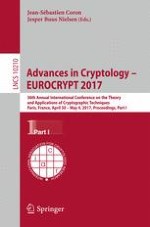2017 | OriginalPaper | Buchkapitel
Formal Abstractions for Attested Execution Secure Processors
verfasst von : Rafael Pass, Elaine Shi, Florian Tramèr
Erschienen in: Advances in Cryptology – EUROCRYPT 2017
Aktivieren Sie unsere intelligente Suche, um passende Fachinhalte oder Patente zu finden.
Wählen Sie Textabschnitte aus um mit Künstlicher Intelligenz passenden Patente zu finden. powered by
Markieren Sie Textabschnitte, um KI-gestützt weitere passende Inhalte zu finden. powered by
